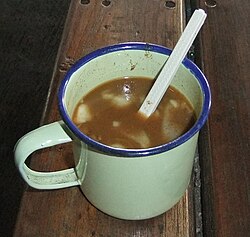Bandrek
In this article, we will explore the topic of Bandrek in depth, analyzing its origins, its impact on society, and its relevance today. Bandrek has been a topic of interest for many years, and its importance has evolved over time. Through a combination of historical research and current analysis, we will examine how Bandrek has influenced different aspects of life, and how it continues to be relevant today. In addition, we will address the various perspectives and opinions that exist around Bandrek, with the aim of providing a complete and enriching vision on this topic. Join us on this journey of exploration and discovery about Bandrek!
 Bandrek in Bandung with bits of young coconut | |
| Course | Beverage |
|---|---|
| Place of origin | Indonesia |
| Region or state | West Java |
| Serving temperature | Hot |
| Main ingredients | Ginger, palm sugar, cinnamon, spices, condensed milk |
Bandrek is a traditional hot, sweet and spicy beverage native to Sundanese of West Java, Indonesia.[1] The Sundanese people who live in the cool, highlands consume bandrek to warm themselves at night and during cold weather.
This hot beverage is made of a mixture of ginger water, palm sugar and cinnamon.[1] Other ingredients such as, star anise, cloves, coriander seeds, cardamom pods, lemongrass, and a small amount of black pepper are sometimes added.[2] Milk can also be added to the mix, depending on one's taste. Sweetened condensed milk or coconut milk is commonly used for this purpose.
It is believed that bandrek has a healing effect on minor health problems, such as sore throat.[citation needed]
Variations
Sometimes pieces of young coconut flesh are added as well. The latest variant includes pieces of durian placed into the bandrek.[2]
See also
References
- ^ a b Yuli Tri Suwarni (April 22, 2005). "Bandung a haven for snack-lovers and shoppers". The Jakarta Post. Archived from the original on August 21, 2014. Retrieved August 20, 2014.
- ^ a b M Yusuf Zain (February 7, 2014). "Torehan Sejarah dalam Segelas Bandrek" (in Indonesian). Kompas.com. Retrieved August 20, 2014.